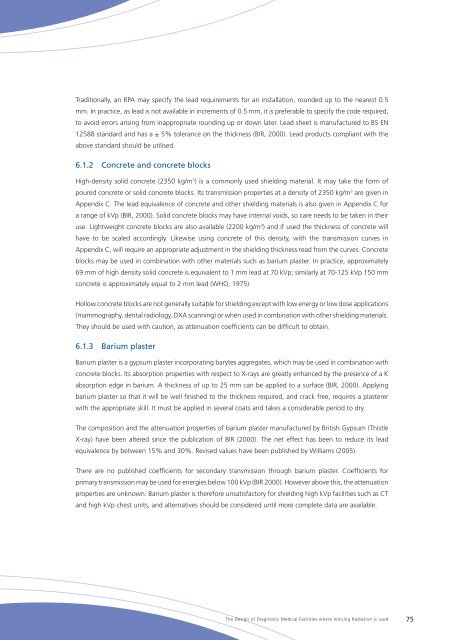The Design of Diagnostic Medical Facilities where ... - ResearchGate
The Design of Diagnostic Medical Facilities where ... - ResearchGate
The Design of Diagnostic Medical Facilities where ... - ResearchGate
Create successful ePaper yourself
Turn your PDF publications into a flip-book with our unique Google optimized e-Paper software.
Traditionally, an RPA may specify the lead requirements for an installation, rounded up to the nearest 0.5<br />
mm. In practice, as lead is not available in increments <strong>of</strong> 0.5 mm, it is preferable to specify the code required,<br />
to avoid errors arising from inappropriate rounding up or down later. Lead sheet is manufactured to BS EN<br />
12588 standard and has a ± 5% tolerance on the thickness (BIR, 2000). Lead products compliant with the<br />
above standard should be utilised.<br />
6.1.2 Concrete and concrete blocks<br />
High-density solid concrete (2350 kg/m 3 ) is a commonly used shielding material. It may take the form <strong>of</strong><br />
poured concrete or solid concrete blocks. Its transmission properties at a density <strong>of</strong> 2350 kg/m 3 are given in<br />
Appendix C. <strong>The</strong> lead equivalence <strong>of</strong> concrete and other shielding materials is also given in Appendix C for<br />
a range <strong>of</strong> kVp (BIR, 2000). Solid concrete blocks may have internal voids, so care needs to be taken in their<br />
use. Lightweight concrete blocks are also available (2200 kg/m 3 ) and if used the thickness <strong>of</strong> concrete will<br />
have to be scaled accordingly. Likewise using concrete <strong>of</strong> this density, with the transmission curves in<br />
Appendix C, will require an appropriate adjustment in the shielding thickness read from the curves. Concrete<br />
blocks may be used in combination with other materials such as barium plaster. In practice, approximately<br />
69 mm <strong>of</strong> high density solid concrete is equivalent to 1 mm lead at 70 kVp; similarly at 70-125 kVp 150 mm<br />
concrete is approximately equal to 2 mm lead (WHO, 1975).<br />
Hollow concrete blocks are not generally suitable for shielding except with low energy or low dose applications<br />
(mammography, dental radiology, DXA scanning) or when used in combination with other shielding materials.<br />
<strong>The</strong>y should be used with caution, as attenuation coefficients can be difficult to obtain.<br />
6.1.3 Barium plaster<br />
Barium plaster is a gypsum plaster incorporating barytes aggregates, which may be used in combination with<br />
concrete blocks. Its absorption properties with respect to X‐rays are greatly enhanced by the presence <strong>of</strong> a K<br />
absorption edge in barium. A thickness <strong>of</strong> up to 25 mm can be applied to a surface (BIR, 2000). Applying<br />
barium plaster so that it will be well finished to the thickness required, and crack free, requires a plasterer<br />
with the appropriate skill. It must be applied in several coats and takes a considerable period to dry.<br />
<strong>The</strong> composition and the attenuation properties <strong>of</strong> barium plaster manufactured by British Gypsum (Thistle<br />
X‐ray) have been altered since the publication <strong>of</strong> BIR (2000). <strong>The</strong> net effect has been to reduce its lead<br />
equivalence by between 15% and 30%. Revised values have been published by Williams (2005).<br />
<strong>The</strong>re are no published coefficients for secondary transmission through barium plaster. Coefficients for<br />
primary transmission may be used for energies below 100 kVp (BIR 2000). However above this, the attenuation<br />
properties are unknown. Barium plaster is therefore unsatisfactory for shielding high kVp facilities such as CT<br />
and high kVp chest units, and alternatives should be considered until more complete data are available.<br />
<strong>The</strong> <strong>Design</strong> <strong>of</strong> <strong>Diagnostic</strong> <strong>Medical</strong> <strong>Facilities</strong> <strong>where</strong> Ionising Radiation is used 75
















